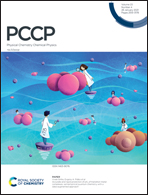On the physicochemical origin of nanoscale friction: the polarizability and electronegativity relationship tailoring nanotribology†
Abstract
Friction is a ubiquitous manifestation of nature, and when it is studied at the nanoscale, complex and interesting effects arise from fundamental physical and chemical surface properties. Surprisingly, and probably due to the complexity of nanofriction studies, this aspect has not been completely discussed in prior studies. To fully consider the physicochemical influence in nanoscale friction, amorphous carbon films with different amounts of hydrogen and fluorine were prepared, chemically characterized, and evaluated via lateral force microscopy. Hydrogen and fluorine were selected because although they exhibit different physicochemical properties, both contribute to frictional force reduction. Indeed, to explain the experimental behavior, it is necessary to propose a new damping constant unifying both polarizability (physical) and electronegativity (chemical) properties. The satisfactory agreement between theory and experiments may encourage and enhance deeper discussion and new experiments that take into account the chemical peculiarities of frictional behavior relating to nanoscale elastic regimes.



 Please wait while we load your content...
Please wait while we load your content...